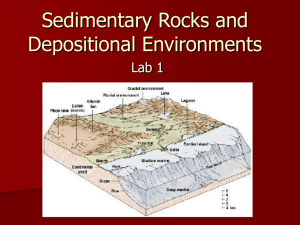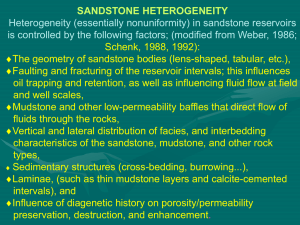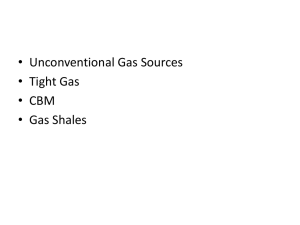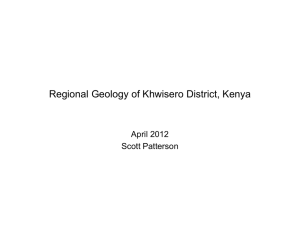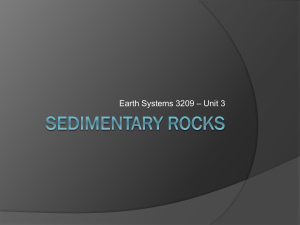Petroleum and Natural Gas in the Nittany Valley Exercise
advertisement
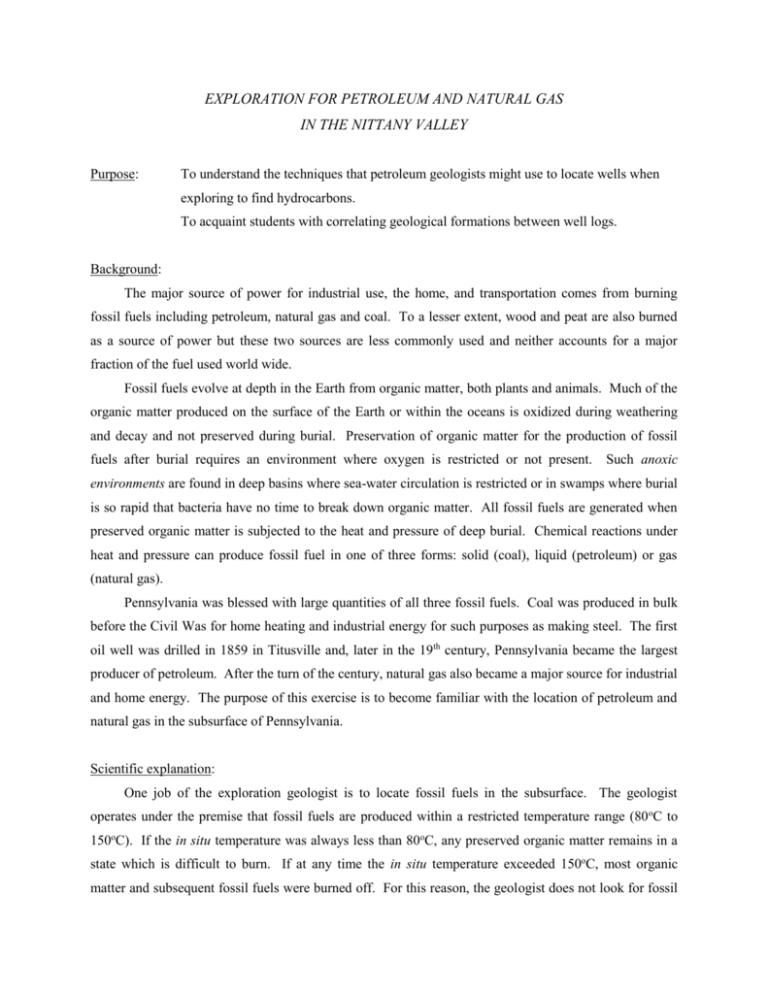
EXPLORATION FOR PETROLEUM AND NATURAL GAS IN THE NITTANY VALLEY Purpose: To understand the techniques that petroleum geologists might use to locate wells when exploring to find hydrocarbons. To acquaint students with correlating geological formations between well logs. Background: The major source of power for industrial use, the home, and transportation comes from burning fossil fuels including petroleum, natural gas and coal. To a lesser extent, wood and peat are also burned as a source of power but these two sources are less commonly used and neither accounts for a major fraction of the fuel used world wide. Fossil fuels evolve at depth in the Earth from organic matter, both plants and animals. Much of the organic matter produced on the surface of the Earth or within the oceans is oxidized during weathering and decay and not preserved during burial. Preservation of organic matter for the production of fossil fuels after burial requires an environment where oxygen is restricted or not present. Such anoxic environments are found in deep basins where sea-water circulation is restricted or in swamps where burial is so rapid that bacteria have no time to break down organic matter. All fossil fuels are generated when preserved organic matter is subjected to the heat and pressure of deep burial. Chemical reactions under heat and pressure can produce fossil fuel in one of three forms: solid (coal), liquid (petroleum) or gas (natural gas). Pennsylvania was blessed with large quantities of all three fossil fuels. Coal was produced in bulk before the Civil Was for home heating and industrial energy for such purposes as making steel. The first oil well was drilled in 1859 in Titusville and, later in the 19th century, Pennsylvania became the largest producer of petroleum. After the turn of the century, natural gas also became a major source for industrial and home energy. The purpose of this exercise is to become familiar with the location of petroleum and natural gas in the subsurface of Pennsylvania. Scientific explanation: One job of the exploration geologist is to locate fossil fuels in the subsurface. The geologist operates under the premise that fossil fuels are produced within a restricted temperature range (80 oC to 150oC). If the in situ temperature was always less than 80oC, any preserved organic matter remains in a state which is difficult to burn. If at any time the in situ temperature exceeded 150oC, most organic matter and subsequent fossil fuels were burned off. For this reason, the geologist does not look for fossil fuels in very recent shallow sediments, nor within metamorphic rocks where temperatures were much greater than 150oC. The ideal depth of burial for the production of oil is between three and four kilometers. This was roughly the depth of burial of rocks in the central Appalachian Mountains which are the present source rocks for much of Pennsylvania’s petroleum and natural gas. Source rocks: Not all rocks are buried to depths of three to four km with organic material still preserved in the matrix. Often both weathering and the depositional environment that produces sandstone lead to oxidation of all organic matter. Likewise, limestones are so permeable that oxidizing fluids move through the limestone to oxidize and ‘burn’ all organic matter. Shales tend to preserve organic material because they have a lower permeability and are deposited in anoxic environments in deep basins. Those black shales with plenty of organic material are called source rocks (i.e., the rocks in which fossil fuels are produced). Reservoir rocks: Many source rocks have a finite permeability which means that although they are shales of very low permeability, the petroleum and natural gas can migrate out of the source rock. Often hydrocarbons migrate because they are less dense than ground water and, hence, are more buoyant. The hydrocarbons will rise like bubbles of air in a lake. This flow by buoyancy usually leads to the migration of petroleum and natural gas to more porous and permeable rocks such as sandstones. Those porous, permeable tocks where fossil fuels are found today are called reservoir rocks. Reservoir rocks usually had very little organic matter during burial but once petroleum and natural gas were generated under appropriate temperature and pressure, these hydrocarbons flow to the reservoir rocks and become trapped. Figure 1. Well-sorted sand and poorly-cemented sandstone: Oriskany Sandstone ( >20%) Figure 2. Poorly-sorted sediment and wellcemented sandstone: Bald Eagle Sandstone ( <10%) Porosity: Oil and natural gas are found in the porosity or open space of rocks. Grains of sand are like marbles in that they are approximately spherical in shape. When many spheres are placed in a container, they cannot fit completely together to fill all the space of the container. The open space between the grains is called pore space. Porosity (represented by the Greek letter ) is a measure of the amount of pore space and is given as a percentage of the volume of the whole rock. Sand will have porosity on the order of 30% or more whereas sandstone has a porosity somewhere between 1% and 20% depending on the amount of compaction and cement in the rock. When cement is added to a sand during diagenesis, the name given to the transformation of a sediment to a rock, cement fills in much of the pore space. Figure 1 shows an idealized cross section of a well sorted but poorly cemented sandstone with large pore space. Figure 2 is a poorly sorted and well cemented sandstone with smaller pore space. The former is like the Pennsylvania glass sand called the Oriskany Sandstone whereas the latter is like the Bald Eagle Sandstone, one of the ridge-forming sandstones of Tussey Mountain. A well cemented sandstone like the Tuscarora Sandstone is shown in figure 3. Figure 3. Well-cemented sandstone: Tuscarora Sandstone ( <2%) Seals: Most rocks have a high enough permeability that hydrocarbons would leak out over geological time periods much like hydrocarbons leak out of the source rocks. However, there are some rocks which have a very low permeability and these are called seals. Two types of seals are fine-grained shale and fault zone rocks. In the case of shale, capillary seals prevent hydrocarbons from flowing. Surface tension allows water to adhere to grains the fill pore throats. With water in pore throats, petroleum and natural gas cannot flow under the force of buoyancy between the individual grains. In the case of fault zone rocks, cement that has been deposited within pore space blocks pore throats and prevents further flow. In order for hydrocarbons to become trapped, the seal has to surround the reservoir rock entirely. Often a complete ‘bottle-like’ seal is not present but a seal on top of the reservoir in the shape of an inverted cup is good enough to trap considerable oil and natural gas. Traps: Seals in the shape of inverted cups are known as structural traps, of which there are two types. First a reservoir rock covered with a shale might be folded into an anticline in the form of an inverted cup or saucer (figure 4). Hydrocarbons are caught under the seal because they have greater buoyancy than water. It is correct to say that oil will float on water as a consequence of the force of buoyancy. Thus under a seal, oil will be found above water. Another type of trap will form if a fault has cut through the reservoir rock. On one side of the reservoir the seal might be a conventional shale, whereas on the other side of the reservoir the seal is a fault zone (figure 5). As seen previously, oil will float on water so the faulted trap has oil on top of water. In either case it is important to appreciate that oil is found because a porous rock is covered with a rock that is essentially impermeable. Figure 4. Reservoir rock under an anticline. Figure 5. Reservoir rock under a fault zone. Geologists can find structural traps using several techniques. First, by mapping surface geology, the geologist can infer the shape of subsurface structures merely by extrapolating what he/she sees at the surface to greater depth. Second, the geologist can use seismic cross sections to find traps. A seismic cross section might look just like your cross section through the Nittany Valley (see figure 7). A seismic section will allow the geologist to map the location of bedding boundaries and then predict likely locations for traps. The third technique involves correlating between wells using well logs. This is the technique used in this exercise. A well log is a record of the formations which were drilled and the depth between the formation boundaries. Exercises: Exploration for petroleum and natural gas This laboratory assumes that you are an investment banker looking to buy shares in recent wells drilled by the Leftwich Producing Company (LPC). You are to work closely with the LPC geologist, Steve Marshak, and the LPC geophysicist, Irene Meglis. LPC has drilled six wells on six different plots of land. The wells are named after the land owners (Gross, Loewy, etc.). Your bank has $100,000 to spend. Your job is to advise your bank on how to invest its money. You can spend the bank’s money in $20,000 lots distributed however you choose between the six wells. Remember that you only have five lots so you cannot purchase a piece of the action in all six wells. Other investment bankers (your classmates) are also going to invest in LPC wells. The profits from each well will be shared according to the number of lots invested in each well. Table 1 gives the well logs for these six wells. Each well log gives the formation names in the order in which they were drilled. The rocks closest to the surface were drilled first and listed at the top of the log. These are the rocks that outcrop. The depth at which each formation boundary was found is marked on each well in a cross section through the area drilled by LPC (figure 6). The position of each well is shown on this cross section. Exercise 1: Construct a cross section through the LPC field by correlating between formations. Data for each well are given in table 1. The formation names are those of the Appalachian Valley and Ridge. Each formation is characterized according to lithology. Your cross section is most easily constructed by writing out the formation names in their proper positions on each of the six logs. The lines marking the formation boundaries between each well show the dip of bedding at the boundary between each formation. Each formation consists of many beds. Exercise 2: Using the description for structural traps given in figures 4 and 5, locate all possible places where oil might have been trapped. Remember that each trap must consist of seal rocks in the shape of an inverted cup or saucer. A porous, permeable reservoir must be found below a seal rock in order for the development of an economic reservoir. Indicate the volume of trapped oil by drawing an oil-water contact (i.e., a horizontal line) 100 meters below the highest point of each reservoir. The 100-meter section of oil is known as the oil column. The volume of trapped oil is proportional to the cross sectional area of the oil. A scale has been provided to help you draw the 100-meter column under the highest point for each trap. Exercise 3: Now divide up into teams or two or more students (as designated by your TA). You and your partner are to discuss how to invest your five lots on the wells drilled by LPC. Partners should discuss the investment in detail amongst themselves. However, it is to your advantage to keep your investment secret from other investment bank partnerships. You would not want to tip other bankers off about how you are going to spend your money. Remember that the more investors there are in each well, the smaller your own fraction of the total profits. After a discussion with your partner(s), write down your plan for investing your money, and explain the choices you have made. Each well has a different value depending on the volume of oil that the well can extract. A rule of thumb is that wells in contact with more oil have a greater value. Although an oil column is 100 meters, not all oil wells will strike oil at the highest point within the trap. More than one well may drill into the same oil pool, but the richer well is the one touching the oil pool at a shallower depth. As an investment banker, one of your first jobs is to decide which wells have greater values (i.e., which wells are in contact with a thicker section of oil). Wells in contact with only water have no value. When considering your investment, you should not lose track of the fact that there may be fewer lots invested on wells in contact with smaller quantities of oil. Note, too, that some of the wells may be dry holes. Part of this exercise is to state the geological rationale for your investment. Your TA will take your bids and tabulate the investment distribution for the class. Bids will not be accepted without a geological rationale for the bid. From these data your TA will determine the wisest investment. Good luck! Prizes will be given to the richest partnerships. Once you have turned in your investment strategy to your TA you will want to examine figure 7. The six wells of Leftwich Producing Company have been drilled into a structure like that found in the Appalachian Valley and Ridge. In fact, the structure looks just like the rocks over the Nittany Mountain Syncline might have looked before they were eroded. Figure 7 gives an indication of how your cross section might fit above the Nittany Mountain Syncline. Table 1: Well Logs for Leftwich Producing Company S. Marshak, chief geologist I. Meglis, chief geophysicist Well Name: Gross Well Name: Fischer Formation Name Lithology Formation Name Lithology Lock Haven marine sandstone Onondaga limestone Brallier marine shale Clinton sandstone (fractured) Hamilton limestone Tuscarora sandstone (high porosity) Onondaga limestone Juniata shale (low permeability) Hamilton limestone Bald Eagle sandstone (high porosity) Onondaga limestone Reedsville marine black shale (source) Clinton sandstone (fractured) Well Name: Younes Well Name: Loewy Formation Name Lithology Formation Name Lithology Onondaga limestone Brallier marine shale Clinton sandstone (fractured) Hamilton limestone Tuscarora sandstone (high porosity) Onondaga limestone Juniata shale (low permeability) Clinton sandstone (fractured) Bald Eagle sandstone (high porosity) Tuscarora sandstone (high porosity) Reedsville marine black shale (source) Clinton sandstone (fractured) Tuscarora sandstone (high porosity) Well Name: Plumb Formation Name Lithology Well Name: Lacazette Onondaga limestone Formation Name Lithology Clinton sandstone/limestone (fractured) Onondaga limestone Tuscarora sandstone (high porosity) Clinton sandstone (fractured) Juniata shale (low permeability) Tuscarora sandstone (high porosity) Bald Eagle sandstone (high porosity) Juniata shale (low permeability) Reedsville marine black shale (source) Bald Eagle sandstone (high porosity) Reedsville marine black shale (source Bald Eagle sandstone (high porosity) Figure 6. Well logs with formation boundaries marked to show the dip of the formation contacts. Figure 7. Hypothetical view of the Nittany Mountain Syncline before erosion.



